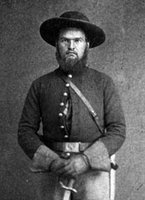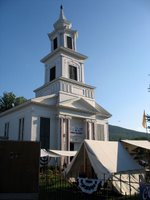Thanks to a Skeptical Pension Examiner

In the mid-1890s, Special Examiner A.G. Greenstreet investigated the case of James W. Landon, late of the Fifth Iowa Cavalry, who claimed that he had suffered a gunshot in the left thigh and was captured by Confederates along the Chattahoochee River near Atlanta in the summer of 1864. Landon further stated that this wound caused a partial paralysis of his leg. Greenstreet became suspicious of the paralysis claim after learning that Landon had been badly injured in his left ankle after a fall from a hay wagon in the early seventies. A skeptical Greenstreet made a preliminary investigation, and recommended that Landon's case be formally investigated.
The investigation request was granted, and Greenstreet opened the case in 1895. He interviewed a number of witnesses, including several of Landon's old army buddies and neighbors — and Landon himself. Landon's twelve page testimony includes minute details of the circumstances surrounding his wounding that I have found no where else. Landon explains that his regiment was routed near Newnan, Ga., on July 31, 1864. In the disorderly retreat that followed, Landon and two comrades — both enlisted men — became separated. For four days they struggled to get back to Union lines, hiding by day and traveling at night. At one point a Confederate patrol spotted them, and during this event Landon received his wound but evaded capture. On August 4, Landon and others were spotted again and this time were taken prisoner. The three men were sent to Andersonville Prison. At some point after this, they became separated. Landon was later transferred to Camp Lawton before being paroled at Savannah in November 1864. Landon survived the ordeal and returned to his regiment. The other two men were also released from prison: Landon W. Silcott (note his first name — a coincidence?) of Company B died of disease at a military hospital in Annapolis, Md., on Dec. 29, 1864. John S. Lemmon served in Company D and went on to become a first lieutenant.
The reference to Andersonville is of particular interest: Landon's military service record makes no mention of his having been imprisoned there, although it does note his stay at Camp Lawton. Landon does not appear on the official list of Andersonville prisoners. Lemmon's name is also not on the list. However, Silcott is a confirmed Andersonville prisoner.
That Landon and Lemmon are not confirmed as prisoners is worthy of further study. It is possible that the details of their capture and imprisonment have escaped notice (until now). My next step is to request the military service and pension records for Silcott and Lemmon to get a fuller picture of their wartime experience. If I am able to find enough evidence, I will bring it to the attention of the folks at Andersonville.
This is my second case of a unconfirmed Andersonville prisoner: Several years ago, while researching the life and military service of Darwin King of the Fourteenth New York Heavy Artillery, I found several references in his pension file to his imprisonment at Andersonville, including affidavits by his comrades. King's name was not on the official list, so I contacted the authorities, who suggested I send copies of all the materials I had collected to them. They reviewed the information and added King's name.
If you have any information about Landon, Lemmon or Silcott, please contact me.
Oh, and I am grateful to Special Examiner Greenstreet: Without his quest for truth and justice, it is very possible that Landon's story might have been forever lost to history.


